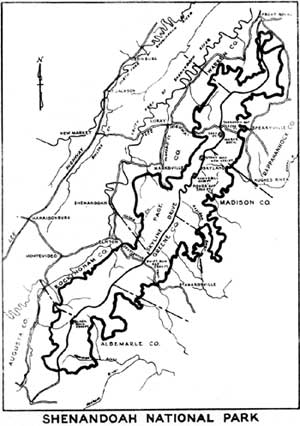|
BEAVER ALONG THE SHENANDOAH
By Otis B. Taylor,
Associate Wildlife Technician.
 |
Within the last few years much interest has been
manifested in reestablishing beaver in Virginia. Successful efforts in
restocking have encouraged research in order to determine the former
status. The earliest explorers who traveled through the wilderness now
included in the Shenandoah National Park, and through the fertile valley
beyond, usually mentioned seeing beaver along the streams that form a
part of the watershed of the park. In consideration of the known fact
that beaver utilize all habitable streams, it may be assumed they
established themselves within the present boundary of the park. John
Lederer is credited with being the first European to reach the Blue
Ridge Mountains. In The Discoveries of John Lederer, In Three Several
Marches from Virginia to the West of Carolina and other parts of the
Continent: Begun in March 1669 and ended in September 1670, the
author states that on his first expedition from "The Head of the
Pamaeonock, alias York River, to the Apalataeon Mountains,---great herds
of red and fallow deer I daily saw feeding; and on the hill-sides, bears
crashing mast like swine.---Beavers and otters I met with on every
stream." Traveling westward from the York River, Lederer is believed to
have ascended the Blue Ridge Mountains within the present Shenandoah
National Park.
The park includes a portion of Augusta and
Rappahannock Counties. The Virginia Magazine of History and Biography
mentions the occurrence of beaver in the former county. In Volume 30,
page 179, we find the following comment:
"Early suit records of Augusta County, Virginia, show
that wolves, deer and elks abounded in the valley, also the beaver, and
the black fox, and for many years, the skins and furs of these animals
was the source of a considerable revenue. This continued until after the
Revolution, and the valley was visited regularly by traders from
Pennsylvania who came to purchase skins and furs. The fact that a
buffalo hide was worth only 33-1/3¢ in 1730, shows how plentiful
the buffalo abounded in the valley."
Tyler's Quarterly Magazine, Volume 1, page 42,
published the following comment on the "District of Rappahannock":
"The following is a summary of a report of Charles
Heilson, of the Duties received on the Exportation of Skins and Furs
within the district of Rappahannock from the 25th. October 1764 to the
25th of April 1769, to the College of William and Mary.---These ships
exported within the time mentioned 2250 buckskins, 4497 doe skins, 69
pds of beaver skins, 112 otter skins, 54 wildcat, 120 mink, 708 fox
skins, 1371 racoon skins, 171 muskrat and 15 elk."

(click on image for an enlargement in a new window)
|
The reference to Rappahannock District may be
construed to mean a portion of land now included in Rappahannock County,
although this is by no means conclusive. The county was formed from
Culpepper County in 1833, taking its name from the river which forms a
part of its boundary. Rappahannock River received its name from an
Indian tribe which lived along its course.
Samuel Kercheval's History of the valley of Virginia,
Fourth Edition, 1925, states on page 30 that the settlement in the
valley commenced about 1734 or 1735. His comment on the status of beaver
and other wildlife is included, due to the proximity of Shenandoah River
to the park. Kercheval said:
"Much the greater part of the country between what is
called the Little North Mountain and the Shenandoah River, at the first
settling of the valley was one vast prairie and like the rich prairies
of the west, afforded the finest possible pasturage for wild animals.
The country abounded in the larger kinds of game. The buffalo, elk,
deer, bear, panther, wild cat, wolf, fox, beaver, otter, and all other
kinds of animals, wild fowl, etc., common to forest countries, were
abundantly plenty."
Note: "These prairies had an artificial cause. At the
close of each hunting season the Indian fired the open ground, and thus
kept it from reverting to woodland. This was done to attract the
buffalo, an animal that shuns the forest. The progressive deforesting of
the lowlands of the valley made the settlement by the whites very easy
and rapid.
Restoring beaver accomplishes much more than merely
reintroducing an animal that builds dams and houses. Their ponds are
used by waterfowl, wading birds, blackbirds, amphibians, reptiles,
mammals depending upon impounded water, numerous insects and
water-tolerant vegetation The resultant community is unique. In the
course of time the food supply of the beaver may become exhausted. It
seeks a new home and develops a new biological environment favorable for
other animals and aquatic plants. The abandoned pond eventually develops
into a low meadow where the trees upon which the beaver exists again
become established and to which the beaver may return. An orderly
succession is developed whereby beaver becomes the benefactor of many
wild creatures and provides an immeasureable interest for man.
Studies conducted by the Service indicate there are
today no beavers of the original stock anywhere within the boundaries of
Shenandoah National Park. A long-time program of restoration is being
launched on a modest scale this season, however, and it is hoped that
eventually the animals will be restored as a part of the park fauna.
|

